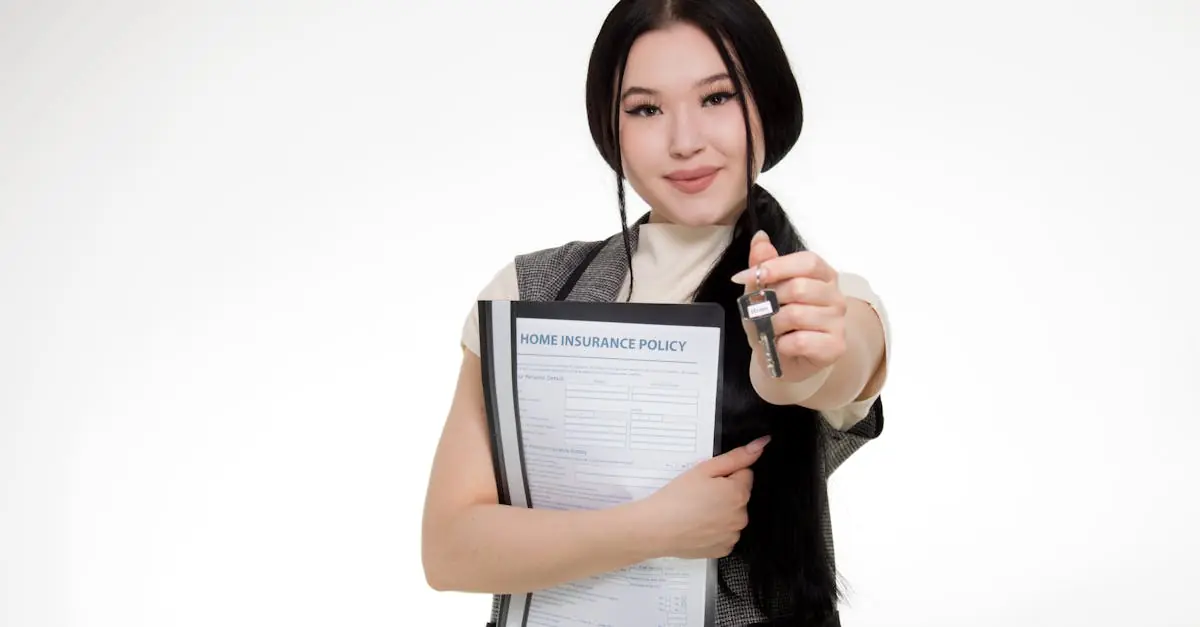When it comes to renting, the security deposit is the unsung hero of the lease agreement. It’s that magical sum of money that landlords collect, promising to return it if tenants don’t turn their apartments into an episode of a home renovation show gone wrong. But what exactly is this mysterious deposit? Is it a safety net for landlords or a landlord’s way of keeping tenants on their toes?
Table of Contents
ToggleWhat Is a Security Deposit?
A security deposit is a sum of money that tenants pay landlords before moving into rental properties. This deposit serves multiple purposes, mainly protecting landlords from financial losses due to damages or unpaid rent. Landlords typically require security deposits to ensure that they can restore the property to its original condition after a tenant vacates.
Security deposits often range from one to three months’ rent. The specific amount depends on various factors, including state laws and the rental market. Most states require landlords to return the security deposit within a certain timeframe after the lease ends, usually around 30 days.
Landlords may deduct amounts from the deposit for specific reasons. These reasons include repairs for damages beyond normal wear and tear, unpaid rent, or cleaning costs if the unit is not left in satisfactory condition. Tenants should document the property’s condition through photographs or videos before moving in and out. This documentation can serve as evidence if discrepancies arise concerning the deposit.
State regulations govern the handling of security deposits. Some jurisdictions impose limits on deposit amounts, while others mandate interest payments to tenants. Understanding these laws helps both parties navigate their rights and responsibilities effectively.
In essence, a security deposit acts as a financial safety net for landlords. It safeguards against potential risks while ensuring that tenants maintain responsibility for the property’s condition.
Purpose of Security Deposits
Security deposits play a crucial role in rental agreements. They safeguard landlords and promote accountability among tenants.
Protection for Landlords
Landlords rely on security deposits to mitigate financial risks. This deposit covers costs such as property damage or unpaid rent. Typically, a deposit covers one to three months’ rent, depending on local regulations. In cases of extensive damage, landlords can deduct repair costs from the deposit. Furthermore, these measures deter neglectful behavior, as tenants understand they must uphold property standards. Provisions for returning deposits also foster transparency between landlords and tenants.
Assurance for Tenants
Tenants gain significant peace of mind through security deposits. Providing this deposit demonstrates their commitment to maintaining the property. Clear documentation of the property’s condition before moving in helps avoid disputes later. Many state laws regulate security deposits to protect tenants, ensuring fairness. Timely return of the deposit encourages a trustworthy relationship between landlords and tenants. Understanding local laws regarding the deposit can empower tenants to make informed decisions.
Legal Considerations
Legal considerations around security deposits vary significantly by state. State-specific laws dictate how much landlords can charge for security deposits, which typically ranges from one to three months’ rent. Some states impose strict limits on the amounts that landlords can collect, aiming to protect tenants from excessive fees. Additionally, certain jurisdictions require landlords to hold deposits in escrow accounts and may mandate interest payments to tenants.
The return process of security deposits often has precise requirements. After the lease ends, landlords generally must return the deposit within 30 days, although this period may differ by state. Deductions from the deposit must relate to specific damages or unpaid rent, with landlords usually needing to provide itemized statements outlining any charges. Following state regulations during the return process helps ensure both parties understand their rights and responsibilities. Documentation of the property’s condition can prevent disputes during this phase.
Common Issues with Security Deposits
Common problems arise around security deposits, with disputes often leading the list.
Disputes Over Deductions
Disputes frequently occur when landlords deduct amounts from the security deposit for damages. Tenants might question the legitimacy of these deductions. They often argue that wear and tear, which landlords might overlook, shouldn’t justify charges. Clear documentation of the property’s condition at move-in and move-out helps resolve these disagreements. An itemized list detailing repairs or cleaning costs supports landlords’ claims, eases tenants’ concerns, and facilitates communication. Both parties benefit from understanding state regulations governing these deductions. Ensuring transparency can help reduce conflicts, allowing for smoother transitions after lease completion.
Unfair Withholding
Unfair withholding of security deposits is another prevalent issue. Landlords may delay or deny the return of deposits for minimal reasons. Tenants may feel frustrated, especially if they’ve maintained the property well. Inconsistent application of state laws adds to the confusion. Timely return, typically within 30 days, and providing itemized statements for deductions are required by law in many states. Failure to comply can lead to legal repercussions for landlords. Tenants who understand their rights are better equipped to challenge unfair practices, making awareness a critical factor in these situations.
Tips for Tenants
Tenants can take several steps to ensure a smooth experience with security deposits. Knowing these tips can help avoid disputes and clarify responsibilities.
Documenting the Condition of the Property
Before moving in, tenants should conduct a thorough walkthrough of the rental property. Taking photographs or videos of each room helps create a visual record. Noting any existing damage, such as scratches or stains, can provide a point of reference later. During the move-out process, tenants should repeat this documentation to demonstrate the property’s condition when vacating. Having this evidence simplifies discussions with landlords about the return of the security deposit. Most importantly, tenants must keep these records organized and accessible to address any potential disputes effectively.
Understanding Lease Agreements
Lease agreements are not just formalities; they outline specific terms related to security deposits. Prior to signing, tenants should carefully read the document for clauses regarding deposit amounts and return conditions. Identifying key details, such as the timeframe for returning deposits and reasons for potential deductions, is essential. Tenants should also look for local laws or regulations mentioned in the lease that govern security deposits. Seeking clarification on any confusing terms or conditions ensures full understanding. A well-informed tenant is better equipped to handle the deposit process and protect their rights throughout the lease term.
Understanding the intricacies of security deposits is crucial for both landlords and tenants. These deposits play a vital role in rental agreements by providing financial protection while fostering accountability. Tenants can safeguard their rights by documenting the property’s condition and familiarizing themselves with state regulations.
Landlords benefit from clear guidelines that help manage deposits effectively and ensure timely returns. By following best practices and being informed, both parties can minimize disputes and maintain a positive rental experience. Ultimately, a well-handled security deposit process strengthens the landlord-tenant relationship and contributes to a smoother rental experience for everyone involved.



